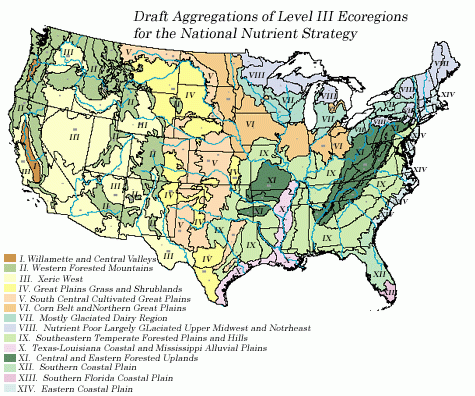Ecoregional Nutrient Criteria for Rivers and Streams

These documents present the U.S. Environmental Protection Agency's nutrient criteria for Rivers and Streams in Ecoregions across the country. They contain the EPA's recommendations to states and authorized Tribes for establishing their water quality standards. These recommended criteria are not laws or regulations - they are guidance that states and Tribes may use as a starting point for the criteria for their water quality standards.
- Ecoregion I: Willamette and Central Valleys (pdf)
- Ecoregion II: Western Forested Mountains (pdf)
- Ecoregion III: Xeric West (pdf)
- Ecoregion IV: Great Plains Grass and Shrublands (pdf)
- Ecoregion V: South Central Cultivated Great Plains (pdf)
- Ecoregion VI: Corn Belt And Northern Great Plains (pdf)
- Ecoregion VII: Mostly Glaciated Dairy Region (pdf)
- Ecoregion VIII: Nutrient-Poor, Largely Glaciated Upper Midwest and Northeast (pdf)
- Ecoregion IX: Southeastern Temperate Forested Plains and Hills (pdf)
- Ecoregion X: Texas-Louisiana Coastal and Mississippi Alluvial Plains (pdf)
- Ecoregion XI: The Central and Eastern Forested Uplands (pdf)
- Ecoregion XII: Southeastern Coastal Plain (pdf)
- Ecoregion XIV: Eastern Coastal Plain (pdf)
- Ecoregional Nutrient Criteria Table for Rivers and Streams (pdf)
